Marking a Floor Elevation on a Plan Drawing
Understanding blueprints - don't people get to school for that sort of affair? We're breaking down a typical construction ready of house plans to help y'all navigate your fashion through the complex web of lines, symbols and terminology of plans.
(If you lot are new to all this, try our helpful primer How to read house plans | The Structure Set up)
In this, our second post in our series "How to read house plans", we're breaking downwardly top drawings!
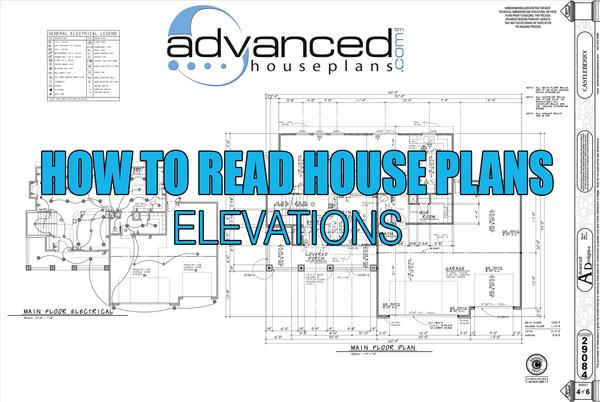
So what is an elevation?
Here'south how I learned information technology in Architecture school:
"An top is an orthographic project of an object or structure on a vertical moving-picture show plan parallel to one of its principal faces." - Francis D.Thou. ChingArchitectural Graphics
In simpler terms, an elevation is a drawing which shows any detail side of a house. If the floor plans are like looking down at a house without a roof, the peak is like looking at it from the side. The drawing is distorted - while y'all and I would await from the street at a house and see depth and perspective, an meridian drawing is compressed into a single aeroplane. Basically, this means that lines are straight upward and down and side to side on paper. I'll explain that more clearly beneath.
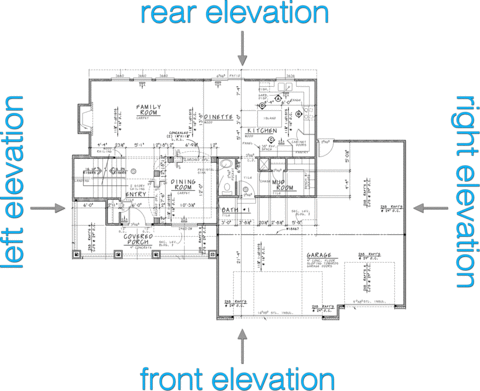
As an instance, let's look at a business firm in 3D. We'll employ our recently design Boston house plan.
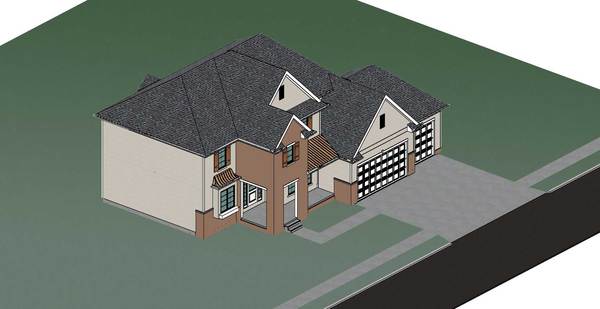
Using the same idea every bit earlier, on the floor plan cartoon, I've drawn arrows to show the primary faces of the firm that will be projected onto our elevation drawings.
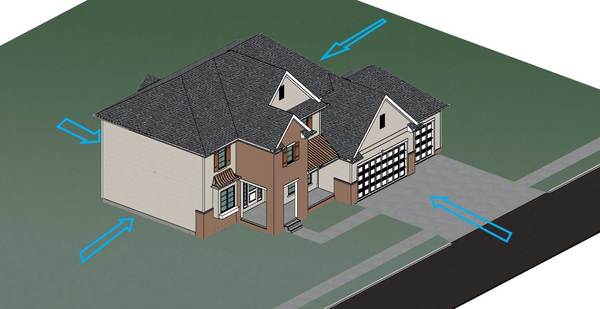
Focusing on the front height, imagine a plane that is parallel to the front walls of the house - or if yous are like me and demand to meet something to sympathise it, take a look below.

On this aeroplane, we will project the lines from the front elevation of the business firm.
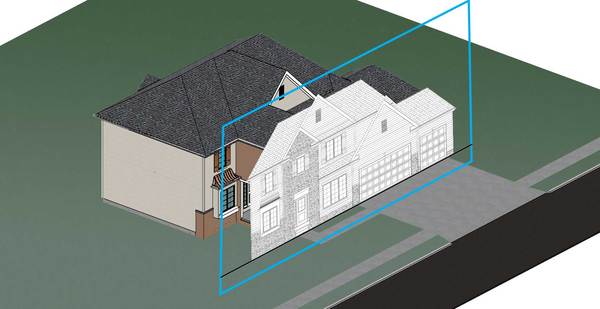
Lone, the elevation cartoon will await similar this.

Discover, none of the lines are skewed every bit y'all might view the house in real life. Vertical lines are straight up and downwards, horizontal lines are straight left and right. Carrying the business firm like this allows the drawing to be accurately scaled and more than merely understood.
Elevations communicate the following information nearly a home:
- Building form
- Materials and overall fashion of a dwelling
- Floor and plate heights
- Roof pitch and fashion
- Window openings and treatment
Let'southward look at a finished elevation cartoon with all the notes, symbols, and lineweight applied.
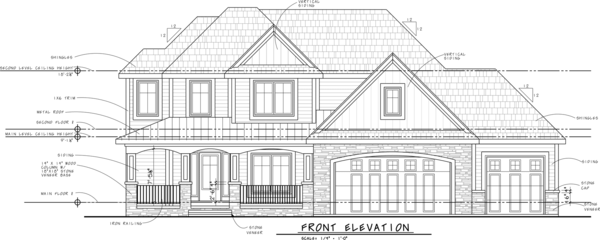
Let'southward point out the major elements.

And at present we'll break it down:
Title and scale
The title tells united states of america which face up of the business firm the drawing represents. Some architects and drafters use compass directions, specifically referring to a face of the home facing a particular direction on a site. Since nosotros don't know how you'll place your domicile in the ground, we brand simplify information technology by referring to how the program is oriented on paper, like the diagram showing how the elevations correspond to the floor plans near the start of this postal service.
Scale tells us how the drawing on paper compares with the real thing built in the real world. We typically use one/4"=1'-0" scale for our elevations. What this ways is that for every 1/4" on the paper, we are representing one'-0" of the habitation in reality. 1" on paper is four', ii" is viii' in the built world, etc. Using a standard scale helps builders in the field scale the drawings and come up upward with an accurate measurement based on the elevations (and most other drawings).
Door + Windows
Openings are drawn on the elevations corresponding to window sizes called out in schedules on the floor plans. Based on the intended style of the home, we evidence the openings with recommended trim, grills (mullions) and other window treatment. Additional windows not found in our opening schedules (like dormer windows) are oft called out in our elevations.
Roof pitch
The roof pitch of a house tells the builder how steep the roof is. This symbol displays two numbers, a ascension and a run. On this pinnacle, the roof pitch is 12/12. What this means is for every 12" of rise there is 12" of run. Roof pitches are e'er expressed with 12" run. Typical roof pitches are vi/12-12/12 in pitch and are called out on every peak of the house corresponding to the pitch on the roof plan.
Height markers
Elevations markers are dashed lines that show where the floor and plate (the elevation of the framed wall) lines of each level correspond to the peak. In some of our designs, we raise wall heights for special rooms and to simplify a roof. In those instances, each unique plate height is called out with its own top marker.
Ground plane
The ground plane represents the estimated location of the ground in relation to the firm. This line is particularly helpful in carrying walkout style homes. Our plans are typically drawn with the ground plane 12" below the top of the foundation, exceeding lawmaking requirements. Nosotros refer the finished class to be determined by the contractor for the specific site the dwelling house is congenital on.
Wrapping it upwardly
While a floor plan can communicate the arrangement of spaces and "menstruation" of a home, elevations help to explain the await and feel of a abode. Information technology's as well an important cartoon for the architect to refer to in putting a house together with actress information that gives visual aid to some of the details called out in a plan.
johnsonappervisrect.blogspot.com
Source: https://www.advancedhouseplans.com/blogs/how-to-read-house-plans-elevations
ارسال یک نظر for "Marking a Floor Elevation on a Plan Drawing"